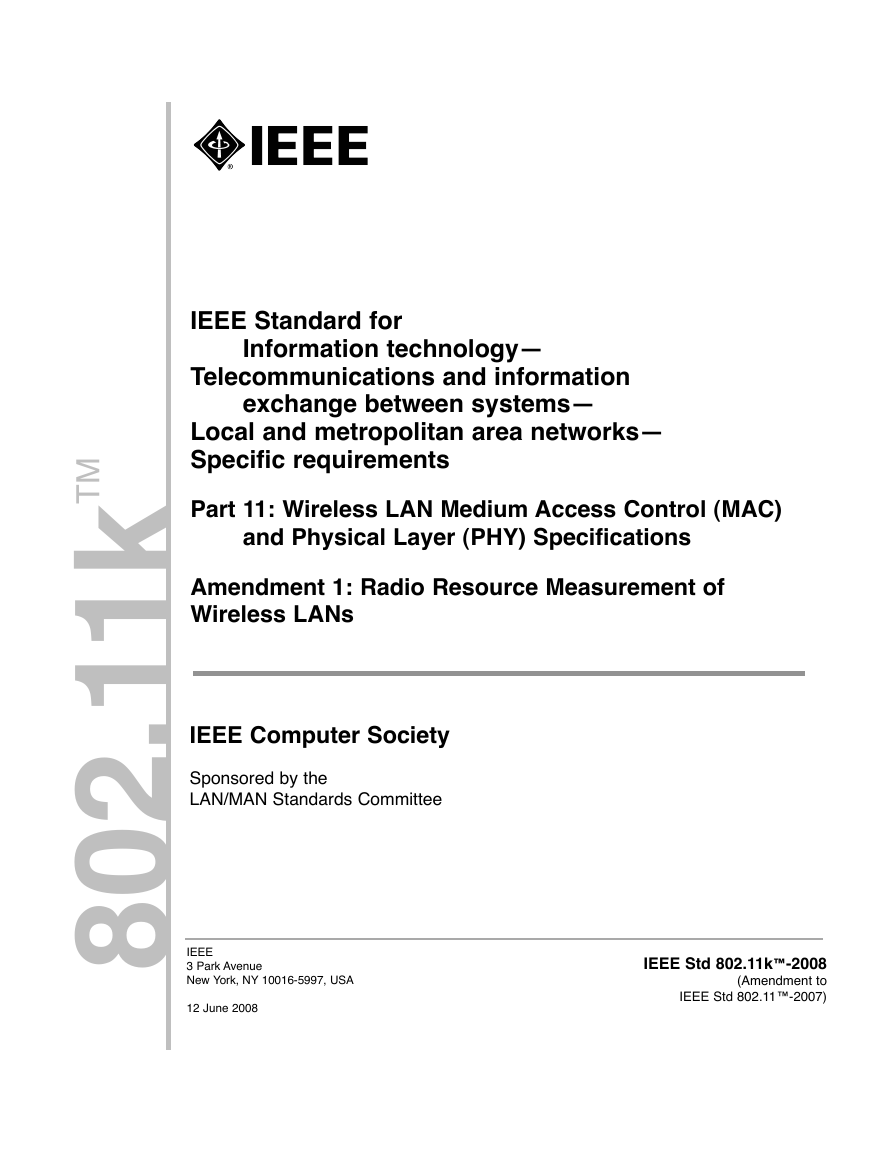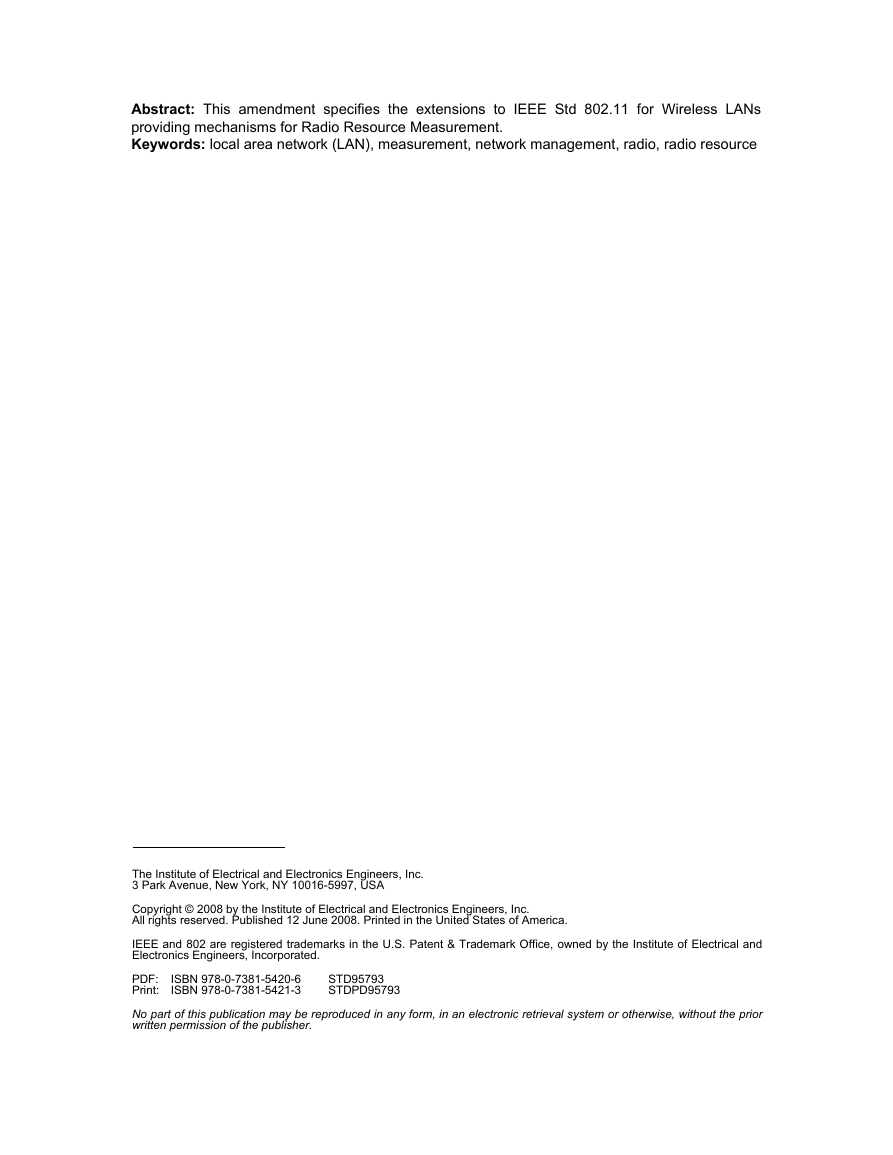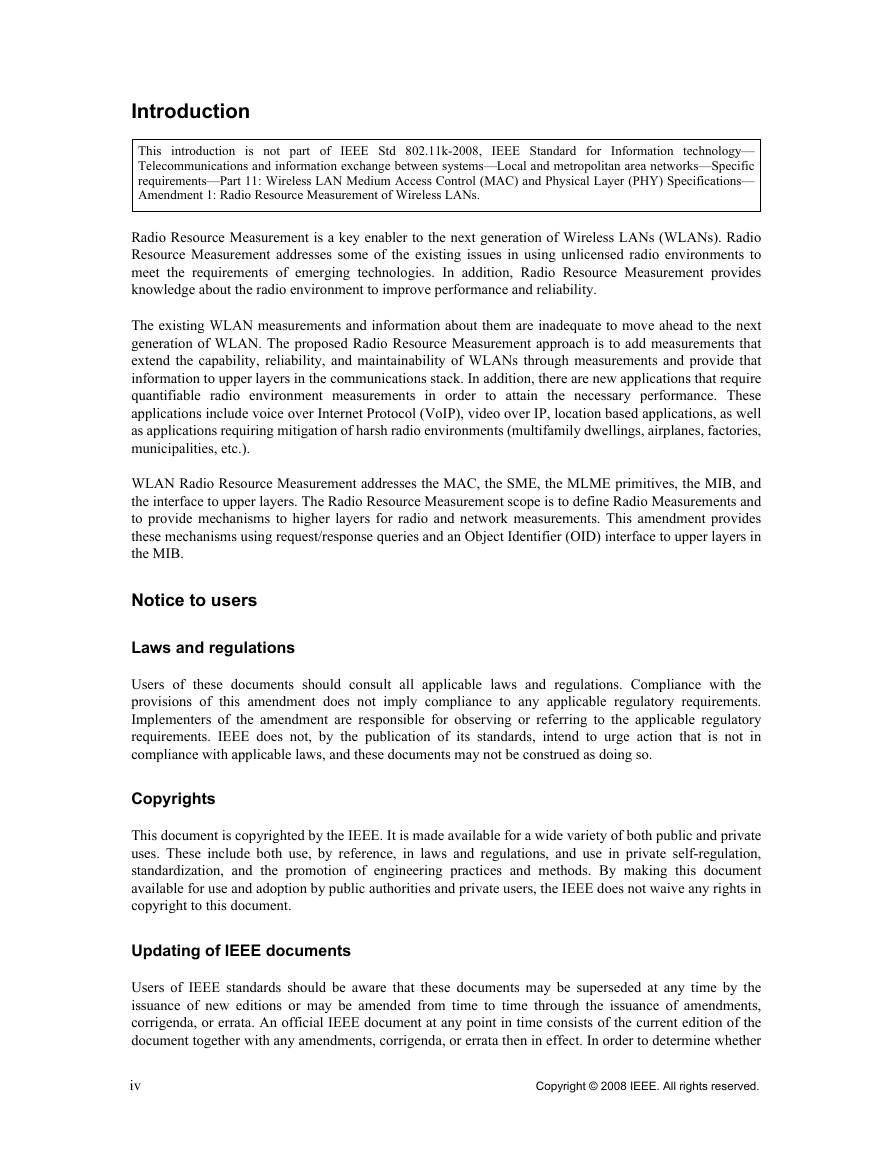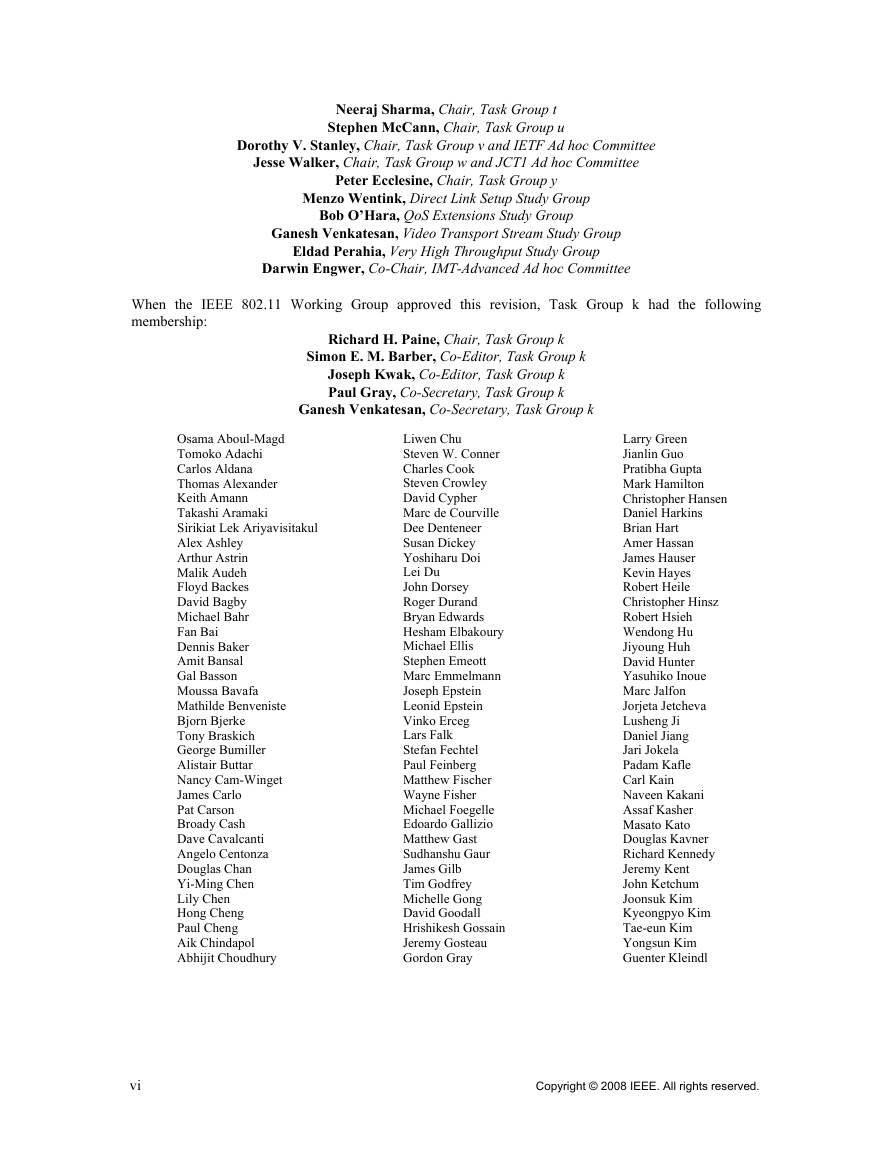Front Cover
Title page
Introduction
Notice to users
Laws and regulations
Copyrights
Updating of IEEE documents
Errata
Interpretations
Patents
Participants
Contents
List of figures
List of tables
Important Notice
2. Normative references
3. Definitions
4. Abbreviations and acronyms
5. General description
5.2 Components of the IEEE 802.11 architecture
5.2.7 Wireless LAN Radio Measurements
5.2.7.1 Beacon
5.2.7.2 Measurement Pilot
5.2.7.3 Frame
5.2.7.4 Channel load
5.2.7.5 Noise histogram
5.2.7.6 STA statistics
5.2.7.7 Location
5.2.7.8 Measurement pause
5.2.7.9 Neighbor report
5.2.7.10 Link measurement
5.2.7.11 Transmit stream/category measurement
5.3 Logical service interfaces
5.3.1 Station service (SS)
5.4 Overview of the services
5.4.7 Radio measurement service
7. Frame formats
7.2 Format of individual frame types
7.2.3 Management frames
7.2.3.1 Beacon frame format
7.2.3.4 Association Request frame format
7.2.3.5 Association Response frame format
7.2.3.6 Reassociation Request frame format
7.2.3.7 Reassociation Response frame format
7.2.3.8 Probe Request frame format
7.2.3.9 Probe Response frame format
7.3 Management frame body components
7.3.1 Fields that are not information elements
7.3.1.4 Capability Information field
7.3.1.11 Action field
7.3.1.18 Measurement Pilot Interval field
7.3.1.19 Max Transmit Power field
7.3.1.20 Transmit Power Used field
7.3.2 Information elements
7.3.2.12 Request information element
7.3.2.18 TPC Report element
7.3.2.21 Measurement Request element
7.3.2.21.4 Channel Load Request
7.3.2.21.5 Noise Histogram Request
7.3.2.21.6 Beacon Request
7.3.2.21.7 Frame Request
7.3.2.21.8 STA Statistics Request
7.3.2.21.9 Location Configuration Information Request
7.3.2.21.10 Transmit Stream/Category Measurement Request
7.3.2.21.11 Measurement Pause Request
7.3.2.22 Measurement Report element
7.3.2.22.4 Channel Load Report
7.3.2.22.5 Noise Histogram Report
7.3.2.22.6 Beacon Report
7.3.2.22.7 Frame Report
7.3.2.22.8 STA Statistics Report
7.3.2.22.9 Location Configuration Information Report
7.3.2.22.10 Transmit Stream/Category Measurement Report
7.3.2.28 BSS Load element
7.3.2.36 AP Channel Report element
7.3.2.37 Neighbor Report element
7.3.2.38 RCPI element
7.3.2.39 BSS Average Access Delay element
7.3.2.40 Antenna Information element
7.3.2.41 RSNI element
7.3.2.42 Measurement Pilot Transmission Information element
7.3.2.43 BSS Available Admission Capacity element
7.3.2.44 BSS AC Access Delay element
7.3.2.45 RRM Enabled Capabilities Element
7.3.2.46 Multiple BSSID Element
7.3.3 Information Subelements
7.4 Action frame format details
7.4.6 Radio Measurement action details
7.4.6.1 Radio Measurement Request frame format
7.4.6.2 Radio Measurement Report frame format
7.4.6.3 Link Measurement Request Frame Format
7.4.6.4 Link Measurement Report Frame Format
7.4.6.5 Neighbor Report Request frame format
7.4.6.6 Neighbor Report Response frame format
7.4.7 Public Action details
7.4.7.1 Public Action frames
7.4.7.2 Measurement Pilot frame format
9. MAC sublayer functional description
9.8 Operation across regulatory domains
9.8.2 Support for FH PHYs
9.8.2.1 Determination of hopping patterns
9.14 MAC frame processing
9.14.1 Extensible element parsing
9.14.2 Extensible subelement parsing
10. Layer management
10.3 MLME SAP interface
10.3.2 Scan
10.3.2.1 MLME-SCAN.request
10.3.2.1.2 Semantics of the service primitive
10.3.2.2 MLME-SCAN.confirm
10.3.2.2.2 Semantics of the service primitive
10.3.6 Associate
10.3.6.2 MLME-ASSOCIATE.confirm
10.3.6.2.2 Semantics of the service primitive
10.3.6.3 MLME-ASSOCIATE.indication
10.3.6.3.2 Semantics of the service primitive
10.3.6.4 MLME-ASSOCIATE.response
10.3.6.4.2 Semantics of the service primitive
10.3.7 Reassociate
10.3.7.2 MLME-REASSOCIATE.confirm
10.3.7.2.2 Semantics of the service primitive
10.3.7.3 MLME-REASSOCIATE.indication
10.3.7.3.2 Semantics of the service primitive
10.3.7.4 MLME-REASSOCIATE.response
10.3.7.4.2 Semantics of the service primitive
10.3.11 Spectrum Management pProtocol layer model for spectrum management and radio measurement
10.3.12 Measurement Request
10.3.12.1 MLME-MREQUEST.request
10.3.12.1.2 Semantics of the service primitive
10.3.12.3 MLME-MREQUEST.indication
10.3.12.3.2 Semantics of the service primitive
10.3.14 Measurement Report
10.3.14.1 MLME-MREPORT.request
10.3.14.1.2 Semantics of the service primitive
10.3.14.3 MLME-MREPORT.indication
10.3.14.3.1 Function
10.3.14.3.2 Semantics of the service primitive
10.3.30 Neighbor Report Request
10.3.30.1 MLME-NEIGHBORREPREQ.request
10.3.30.1.1 Function
10.3.30.1.2 Semantics of the service primitive
10.3.30.1.3 When Generated
10.3.30.1.4 Effect of Receipt
10.3.30.2 MLME-NEIGHBORREPREQ.confirm
10.3.30.2.1 Function
10.3.30.2.2 Semantics of the service primitive
10.3.30.2.3 When Generated
10.3.30.2.4 Effect of Receipt
10.3.30.3 MLME-NEIGHBORREPREQ.indication
10.3.30.3.1 Function
10.3.30.3.2 Semantics of the service primitive
10.3.30.3.3 When Generated
10.3.30.3.4 Effect of Receipt
10.3.31 Neighbor Report Response
10.3.31.1 MLME-NEIGHBORREPRESP.request
10.3.31.1.1 Function
10.3.31.1.2 Semantics of the service primitive
10.3.31.1.3 When Generated
10.3.31.1.4 Effect of Receipt
10.3.31.2 MLME-NEIGHBORREPRESP.confirm
10.3.31.2.1 Function
10.3.31.2.2 Semantics of the service primitive
10.3.31.2.3 When Generated
10.3.31.2.4 Effect of Receipt
10.3.31.3 MLME-NEIGHBORREPRESP.indication
10.3.31.3.1 Function
10.3.31.3.2 Semantics of the service primitive
10.3.31.3.3 When Generated
10.3.31.3.4 Effect of Receipt
10.3.32 Link Measure Request
10.3.32.1 MLME-LINKMEASURE.request
10.3.32.1.1 Function
10.3.32.1.2 Semantics of the service primitive
10.3.32.1.3 When Generated
10.3.32.1.4 Effect of Receipt
10.3.32.2 MLME-LINKMEASURE.confirm
10.3.32.2.1 Function
10.3.32.2.2 Semantics of the service primitive
10.3.32.2.3 When Generated
10.3.32.2.4 Effect of Receipt
11. MLME
11.1 Synchronization
11.1.3 Acquiring synchronization, scanning
11.1.3.2 Active scanning
11.1.3.2.1 Sending a probe response
11.1.3.3 Initializing a BSS
11.3 STA authentication and association
11.8 TPC procedures
11.8.2 Specification of regulatory and local maximum transmit power levels
11.10 Radio measurement procedures
11.10.1 Measurement on operating and non-operating channels
11.10.2 Measurement start time
11.10.3 Measurement Duration
11.10.4 Station responsibility for conducting measurements
11.10.5 Requesting and reporting of measurements
11.10.6 Repeated measurement request frames
11.10.7 Triggered Autonomous Reporting
11.10.8 Specific measurement usage
11.10.8.1 Beacon Report
11.10.8.2 Frame Report
11.10.8.3 Channel Load Report
11.10.8.4 Noise Histogram Report
11.10.8.5 STA Statistics Report
11.10.8.6 Location Configuration Information Report
11.10.8.7 Measurement Pause
11.10.8.8 Transmit Stream/Category Measurement Report
11.10.9 Usage of the Neighbor Report
11.10.9.1 Requesting a Neighbor Report
11.10.9.2 Receiving a Neighbor Report
11.10.10 Link Measurement
11.10.11 Multiple BSSID Set
11.10.12 Measurement Pilot generation and usage
11.10.12.1 Measurement Pilot generation by an AP
11.10.12.2 Measurement Pilot usage by a STA
11.10.13 Access Delay Measurement
11.10.14 BSS Available Admission Capacity
11.10.15 AP Channel Report
12. PHY service specification
12.3 Detailed PHY service specifications
12.3.4 Basic service and options
12.3.4.3 PHY-SAP service primitives parameters
12.3.5 PHY-SAP detailed service specification
12.3.5.8 PHY-CCARESET.request
12.3.5.8.1 Function
12.3.5.8.2 Semantics of the service primitive
12.3.5.8.3 When generated
12.3.5.8.4 Effect of receipt
12.3.5.9 PHY-CCARESET.confirm
12.3.5.9.1 Function
12.3.5.9.2 Semantics of the service primitive
12.3.5.10 PHY-CCA.indication
12.3.5.10.1 Function
12.3.5.10.2 Semantics of the service primitive
12.3.5.11 PHY-RXSTART.indication
12.3.5.11.2 Semantics of the service primitive
12.3.5.12 PHY-RXEND.indication
12.3.5.12.2 Semantics of the service primitive
15. DSSS PHY specification for the 2.4 GHz band designated for ISM applications
15.2 DSSS PLCP sublayer
15.2.7 Receive PLCP
15.4 DSSS PMD sublayer
15.4.4 Basic service and options
15.4.4.2 PMD_SAP peer-to-peer service primitive parameters
15.4.4.3 PMD_SAP sublayer-to-sublayer service primitives
15.4.4.4 PMD_SAP service primitive parameters
15.4.5 PMD_SAP detailed service specification
15.4.5.16 PMD_RCPI.indicate
15.4.5.16.1 Function
15.4.5.16.2 Semantics of the service primitive
15.4.5.16.3 When generated
15.4.5.16.4 Effect of receipt
15.4.8 PMD receiver specifications
15.4.8.5 Received Channel Power Indicator Measurement
17. Orthogonal frequency division multiplexing (OFDM) PHY specification for the 5 GHz band
17.2 OFDM PHY specific service parameter list
17.2.3 RXVECTOR parameters
17.2.3.5 RXVECTOR RCPI
17.3 OFDM PLCP sublayer
17.3.10 PMD receiver specifications
17.3.10.6 Received Channel Power Indicator Measurement
17.3.12 Receive PLCP
17.5 OFDM PMD sublayer
17.5.4 Basic service and options
17.5.4.2 PMD_SAP sublayer-to-sublayer service primitives
17.5.4.3 PMD_SAP service primitive parameters
17.5.5 PMD_SAP detailed service specification
17.5.5.8 PMD_RCPI.indicate
17.5.5.8.1 Function
17.5.5.8.2 Semantics of the service primitive
17.5.5.8.3 When generated
17.5.5.8.4 Effect of receipt
18. High Rate direct sequence spread spectrum (HR/DSSS) PHY specification
18.2 High Rate PLCP sublayer
18.2.6 Receive PLCP
18.3 High Rate PLME
18.3.5 Vector descriptions
18.4 High Rate PMD sublayer
18.4.4 Basic service and options
18.4.4.2 PMD_SAP sublayer-to-sublayer service primitives
18.4.5 PMD_SAP detailed service specification
18.4.5.16 PMD_RCPI.indicate
18.4.5.16.1 Function
18.4.5.16.2 Semantics of the service primitive
18.4.5.16.3 When generated
18.4.5.16.4 Effect of receipt
18.4.8 PMD receiver specifications
18.4.8.5 Received Channel Power Indicator Measurement
19. Extended Rate PHY specification
19.2 PHY specific service parameter list
19.9 Extended rate PMD sublayer
19.9.4 Basic service and options
19.9.4.2 PMD_SAP sublayer-to-sublayer service primitives
19.9.4.3 PMD_SAP service primitive parameters
19.9.5 PMD_SAP detailed service specification
19.9.5.13 PMD_ED.indicate
19.9.5.14 PMD_RCPI.indicate
Annex A (informative) Protocol Implementation Statement (PICS) proforma
A.4 PICS proforma—IEEE Std 802.11-2007
Annex D (normative) ASN.1 encoding of the MAC and PHY MIB
Annex I (informative) Regulatory classes
I.1 External regulatory references
Annex J (normative) Country information element and regulatory classes
Annex Q (normative) ASN.1 encoding of the RRM MIB
















 2023年江西萍乡中考道德与法治真题及答案.doc
2023年江西萍乡中考道德与法治真题及答案.doc 2012年重庆南川中考生物真题及答案.doc
2012年重庆南川中考生物真题及答案.doc 2013年江西师范大学地理学综合及文艺理论基础考研真题.doc
2013年江西师范大学地理学综合及文艺理论基础考研真题.doc 2020年四川甘孜小升初语文真题及答案I卷.doc
2020年四川甘孜小升初语文真题及答案I卷.doc 2020年注册岩土工程师专业基础考试真题及答案.doc
2020年注册岩土工程师专业基础考试真题及答案.doc 2023-2024学年福建省厦门市九年级上学期数学月考试题及答案.doc
2023-2024学年福建省厦门市九年级上学期数学月考试题及答案.doc 2021-2022学年辽宁省沈阳市大东区九年级上学期语文期末试题及答案.doc
2021-2022学年辽宁省沈阳市大东区九年级上学期语文期末试题及答案.doc 2022-2023学年北京东城区初三第一学期物理期末试卷及答案.doc
2022-2023学年北京东城区初三第一学期物理期末试卷及答案.doc 2018上半年江西教师资格初中地理学科知识与教学能力真题及答案.doc
2018上半年江西教师资格初中地理学科知识与教学能力真题及答案.doc 2012年河北国家公务员申论考试真题及答案-省级.doc
2012年河北国家公务员申论考试真题及答案-省级.doc 2020-2021学年江苏省扬州市江都区邵樊片九年级上学期数学第一次质量检测试题及答案.doc
2020-2021学年江苏省扬州市江都区邵樊片九年级上学期数学第一次质量检测试题及答案.doc 2022下半年黑龙江教师资格证中学综合素质真题及答案.doc
2022下半年黑龙江教师资格证中学综合素质真题及答案.doc